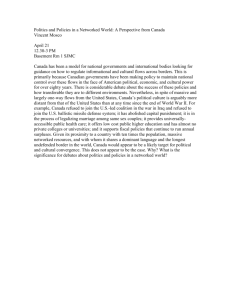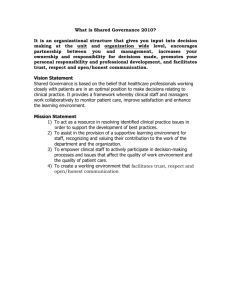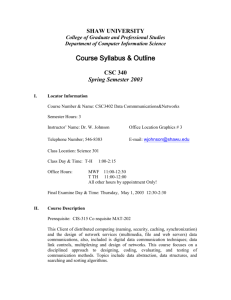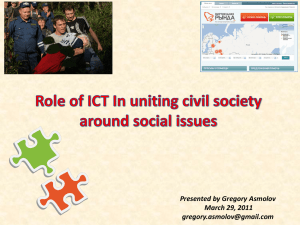networked - International Institute for Sustainable Development
advertisement
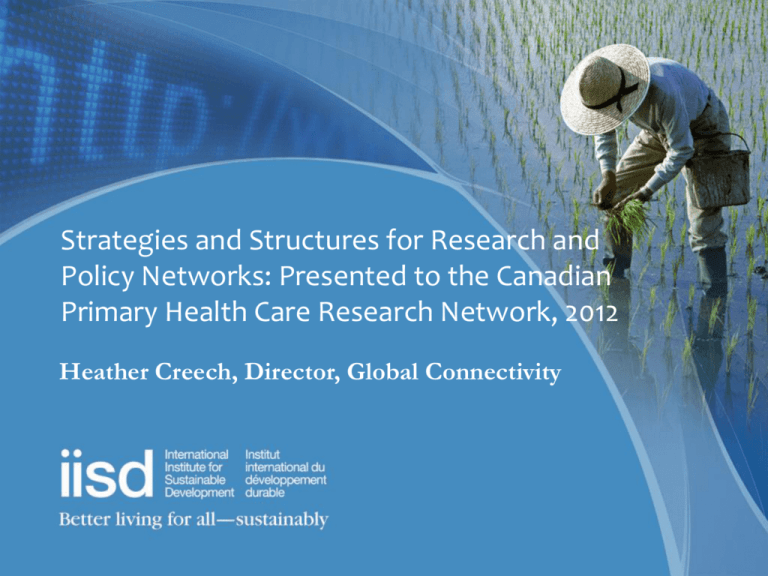
Strategies and Structures for Research and Policy Networks: Presented to the Canadian Primary Health Care Research Network, 2012 Heather Creech, Director, Global Connectivity IISD’s Networks Practice Why we became involved in strategic planning and evaluation of networks and partnerships • The intersection of technology and social organization • Increasing international interest in the role of knowledge and collaborative process as necessary to sustainable development implementation Evidence and consent • The potential for “networked” governance to address complex problems Managing complex problems by using networks Networked governance is… “not a search for the optimal solution to one problem but an ongoing learning and negotiation process where a high priority is given to questions of communication, perspective sharing, and the development of adaptive group strategies for problem solving” (PahlWostl and Hare, 2004) Necessary conditions for “networked” governance • Social capital Social capital has been shown to be related to the capacity of teams to process information, make sense of data and connect it to an empirical context. • Social capital built through Creation of shared value Knowledge sharing, learning, exploration and experimentation Drivers: institutional and individual Networked governance and the place for research and policy networks • If there is insufficient social capital for a networked approach, there is still a need for research and policy networks to inform active steering and centralized problem solving (Huppé et al, 2012). Structures for collaboration • The limits of typologies Formal/informal; focus/extensiveness • Two basic structures Groups of institutions • Inter-organizational relationships • Driven by institutional mandates and interests Groups of individuals • Communities of practice, knowledge networks, expert networks • Driven by self interest and/or shared challenges Some recent lessons • Knowledge sharing and subsidiarity • Recognition of social capital and personal social networks • Shared value creation • Recognizing and mitigating the impact of the 1-9-90 rule • Recognizing and mitigating the impact of “Dunbar’s number” • The role of social network analysis in practical network planning and management • Recognizing adaptive cycles in network evolution EXPLORATION MATURITY/CONSERVATION New Ideas: Creative * Messy * Uncertain* First-hand insights * Outside ideas * Multiple Perspectives * Flat structure & process * Probes & Little Experiments * Options Productivity: Efficiency * Certainty * Stability * Hierarchical structure & process * Clear Tasks, Rules, Policies & Procedures * Standardization * Specialists * Fast Returns * Low Risk Tolerance expand possibilities new place & buy-in thinking bets choice sustain birth & grow develop & adapt refine conserve crisis broad direction confusion shared vision reconnect Effectiveness: Entrepreneurial * Generalists * Roles * Adaptive structure and process * Prototypes & Pilot Projects * Variation * Lag times •Flexible funding * Flexible rules * Tolerance for •Risk * Dead ends * Emerging Practice DEVELOPMENTAL declining ROI manage Vision: Charismatic * Unraveling * Chaotic * Loss, Anger, Blame, Conflict * Little structure or process * Reflection * Relationships * Essence * Values * Principles * New Energy & Urgency CREATIVE DESTRUCTION/RELEASE From: Cabaj, M. Network Death & Renewal in the Adaptive Cycle, 2011. Critical success factors for performance of networks • Purpose, focus, roles; shared understanding • Leadership and coordination • Knowledge sharing and communications skills • Understanding short- and long-term needs and outcomes • Organizational capacity and commitment • Monitoring and assessment: Relevance, Effectiveness, Efficiency, Impact and sustainability Critical success factors for sustainability of networks • • • • Timing Relevance Relationships Resources [from: Willard & Creech, 2006] Operating models for sustainability of research networks • Centralized – Hosted, with external support – Hosted, with institutional membership fees – Hosted, with internal, in-kind support for coordination and • Decentralized – National, semi-autonomous, chapters – Professional association model, with membership dues – Virtual model (e.g., through Linked In) A range of questions for consideration • • • • • • • • • • • • • What is the need? [demand] Who are the stakeholders/boundary partners/members/constituency? How to integrate the beneficiaries into knowledge sharing? What are the special conditions for each region? What are the major research questions ? What inputs are available to meet the need? [people and information][supply] What is the capacity to access/use the inputs to meet the need? What is the competition? [other sources of inputs to meet the need] What are the institutional and individual drivers to use the inputs? What are the enabling conditions and incentives? What are the institutional barriers to access/use the inputs? What are the phases and the timeframe? What coordination is needed?
